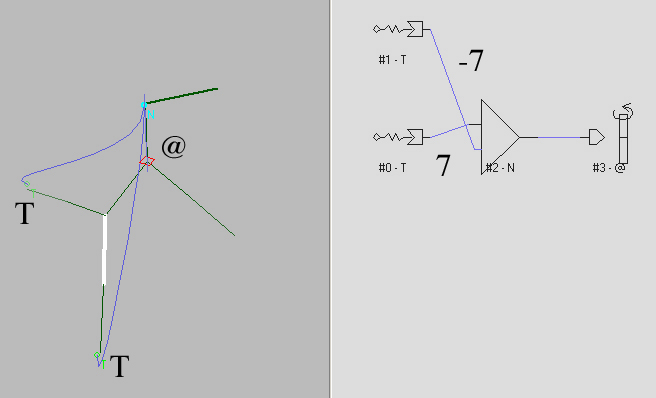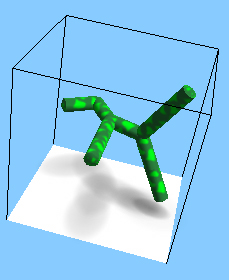The following 10 genotypes have been obtained applying
pure crossover on the original genotypes showed at the
beginning of the list. Please comment the crossover you can
observe and give some conclusions about the crossover operator
implemented in FRAMSTICKS.
Original
creatures:
Basic Quadruped :
MX[@*:-.4,2:-2.890,1
:-1.808](RX(FX,),MX[@-1
:1.849,0:3.094,0:-1.387][|-1
:1.287,0:.5](rX(,X),,RX(X,)),rX(,FX))
Food finder worm :
fffX(fffIX[S:-1.556],RRlFFFMMMX[|-1:-10,3:10]llllFFMMMX[|1:-4.450]RlllFFFMMMX[|G:-1.404],fffIX[S:1])
Crossover results (10 examples):
Crossing over of 'Basic Quadruped' (44.85%) and 'Basic
Quadruped' (55.15%):
MXMX[@*:-.4,2:-2.890,1
:-1.808](RX(FX,),MX[@-1
:1.849,0:3.094,0:-1.387][|-1
:1.287,0:.5](rX(,X[@-1
:1.849,0:3.094,0:-1.387][|-1
:1.287,0:.5](rX(,X),,RXX,)),rX,FX))
Crossing over of 'Food finder worm' (56.12%) and 'Basic
Quadruped' (43.88%):
fffX(fffIX[S:-1.556],RRlFFFMMMX[|-1:-10,3:10]llllFFMMMX[@-1
:1.849,0:3.094,0:-1.387][|-1
:1.287,0:.5](rX(,X),,RXX,)[|G:-1.404],fffIX[S:1])
Crossing over of 'Food finder worm' (29.25%) and 'Basic
Quadruped' (70.75%):
fffX(fffIX[S:-1.556]X(FX,),MX[@-1
:1.849,0:3.094,0:-1.387][|-1
:1.287,0:.5](rX(,X),,RX(X,)),rXfffIX[S:1])
Crossing over of 'Basic Quadruped' (66.67%) and 'Food finder
worm' (33.33%):
MX[@*:-.4,1:-2.890,1
:-1.808](RX(llFFMMMX[|0:-4.450]RlllFFFMMM(rX(,X),,RX(X,)),rX,FX))
Crossing over of 'Basic Quadruped' (46.91%) and 'Basic
Quadruped' (53.09%):
MX[@*:-.4,2:-2.890,1
:-1.808](RX(FMX[@*:-.4,2:-2.890,1
:-1.808](RX(FX,),MX[@-1
:1.849,0:3.094,0:-1.387][|-1
:1.287,0:.5][|-1
:1.287,0:.5](rX(,X),,RXX,)),rX,FX))
Crossing over of 'Basic Quadruped' (86.72%) and 'Basic
Quadruped' (13.28%):
MX[@*:-.4,2:-2.890,1
:-1.808](RX(FX,),MX[@-1
:1.849,0:3.094,0:-1.387][|-1
:1.287,0:.5](r(rX(,X),,RX(X,)),X(,X),,RX(X,)),rX(,FX))
Crossing over of 'Food finder worm' (44.07%) and 'Basic
Quadruped' (55.93%):
fffX(X(FX,),MX[@0
:1.849,0:3.094,0:-1.387][|-1
:1.287,0:.5](rX,X),,RXMX[|1:-4.450]RlllFFFMMMX[|G:-1.404],fffIX[S:1])
Crossing over of 'Basic Quadruped' (95.10%) and 'Basic
Quadruped' (4.90%):
MX[@*:-.4,2:-2.890,1
:-1.808](RX(FX,),MX[@-1
:1.849,0:3.094,0:-1.387][|-1
:1.287,0:.5](rX(,X)X,),MFX)
Crossing over of 'Basic Quadruped' (99.07%) and 'Basic
Quadruped' (0.93%):
MX[@*:-.4,2:-2.890,1
:-1.808](RX(FX,),MX[@-1
:1.849,0:3.094,0:-1.387][|-1
:1.287,0:.5](rX(,X),,RX(X,)),,X)
Crossing over of 'Food finder worm' (95.96%) and 'Food
finder worm' (4.04%):
fffX(fffIX[S:-1.556],RRlFFFMMMX[|-1:-10,3:10]llllFFFMX[|1:-4.450]RlllFFFMMMX[|G:-1.404],fffIX[S:1])



